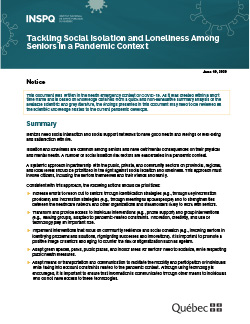COVID-19: Tackling Social Isolation and Loneliness Among Seniors in a Pandemic Context
This document was written in the health emergency context of COVID-19. As it was created within a short time frame and is based on knowledge obtained from a quick and non-exhaustive summary analysis of the available scientific and grey literature, the findings presented in this document may need to be reviewed as the scientific knowledge related to the current pandemic develops.
Seniors need social interaction and social support networks to have good health and feelings of well-being and satisfaction with life.
Isolation and loneliness are common among seniors and have detrimental consequences on their physical and mental health. A number of social isolation risk factors are exacerbated in a pandemic context.
A systemic approach in partnership with the public, private, and community sectors on provincial, regional, and local levels should be prioritized in the fight against social isolation and loneliness. This approach must involve citizens, including the seniors themselves and their friends and family.
Consistent with this approach, the following actions should be prioritized:
- Increase efforts to reach out to seniors through identification strategies (e.g., through key information providers) and information strategies (e.g., through meaningful spokespeople) and to strengthen ties between the healthcare network and other organizations and stakeholders likely to work with seniors.
- Transform and provide access to individual interventions (e.g., phone support) and group interventions (e.g., walking groups), adapted to pandemic-related constraints. Innovation, creativity, and use of technology play an important role.
- Implement interventions that focus on community resilience and social cohesion (e.g., involving seniors in identifying problems and solutions, highlighting successes and innovations). It is important to promote a positive image of seniors and aging to counter the risk of stigmatization such as ageism.
- Adapt green spaces, parks, public plazas, and indoor areas for seniors’ need to socialize, while respecting public health measures.
- Adapt means of transportation and communication to facilitate the mobility and participation of individuals while taking into account constraints related to the pandemic context. Although using technology is encouraged, it is important to ensure that information is communicated through other means to individuals who do not have access to these technologies.
- Ensure that the public policies adopted for the pandemic context cause minimal harm to seniors and conduct ongoing analysis of their impact on seniors’ social isolation and opportunities for social participation.
- Take into account the fact that the pandemic hits regions, living environments, and people unequally, in order to reduce such inequalities that can affect seniors.
AUTHOR
Comité en prévention et promotion [Disease Prevention and Health Promotion Committee]
This document was written in the health emergency context of COVID-19. As it was created within a short time frame and is based on knowledge obtained from a quick and non-exhaustive summary analysis of the available scientific and grey literature, the findings presented in this document may need to be reviewed as the scientific knowledge related to the current pandemic develops.


